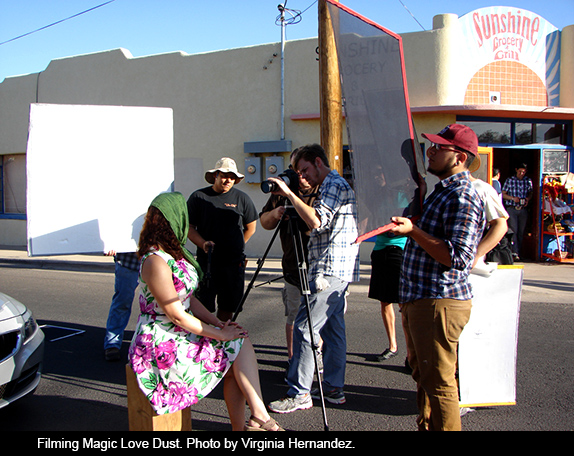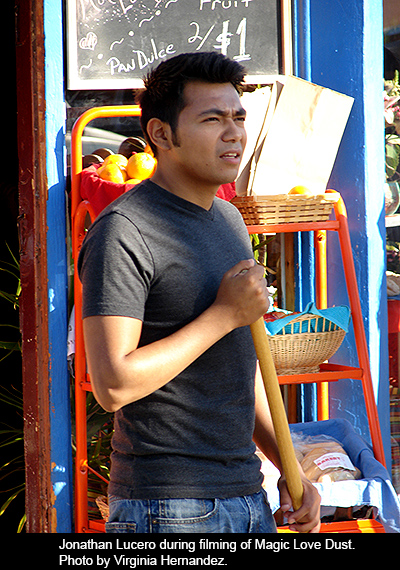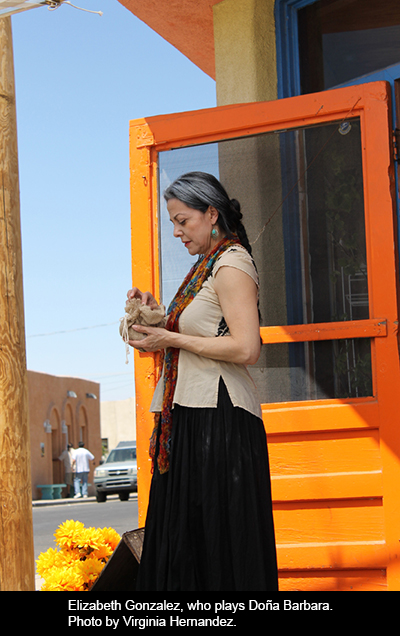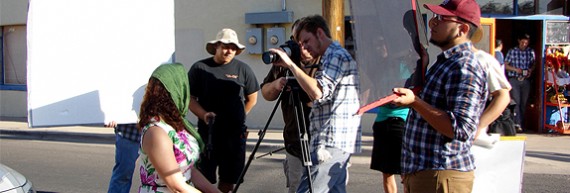
There’s always a good deal of publicity about Hollywood and/or alternative films made in New Mexico. Since the Richardson administration, the industry has been billed as one that can bring revenue and jobs to the state, while making use of our unique landscape and diverse local talent.
In the latter category, union considerations generally mean that the best behind-the-scenes jobs go to people from out of state. Nonetheless, in recent years a New Mexican contingent of filmmakers and others linked to the business has developed. Readers may be interested in rereading Jeremy Shattuck’s provocative piece about the New Mexico filmmaking scene from one participant’s point of view.
As with many such loudly advertised projects, recent filmmaking here hasn’t been all smooth sailing. Special interests, the ambitions of some at the expense of others, and a number of other problems have slowed expectations. Nevertheless, the television series Breaking Bad proved to be one of the best written, directed and acted series in the history of TV, justly placing Albuquerque on the international entertainment map.

When my grandchildren visited from Uruguay last year, they wanted to see as many of the Breaking Bad locations as possible. They were thrilled by a stop at “Walter White’s house.” One of the series’ secondary characters, Steven Michael Quezada, who played Drug Enforcement Administration agent Seven Gomez in the series, liked our city enough to make his home here, and was elected to the Albuquerque School Board in February 2013.
New Mexico has long had a rich filmmaking history. During the early 20th century, more than 100 films were made in Las Vegas, New Mexico alone. A great number of these were of the old silent genre. Tom Mix starred in many of them, and even took up residence in Las Vegas for a number of years.
Salt of the Earth (1954) is one of the all-time great black and white films, and still regularly moves audiences worldwide. It tells the story of the Salt of the Earth miners strike near Silver City, New Mexico, particularly the significant role of women in that strike. It has been the focus of books, essays, conferences, and endless projections ever since. Some of those who carried out the strike also acted in the film.
The Milagro Beanfield War (1988) brought the John Nichols novel of the same name to the screen under the direction of Robert Redford. The story of a northern New Mexico man defending his bean field from the encroachment of big developers—an issue that continues to be relevant in the state—was filmed in the northern New Mexican village of Truchas, where locations stood in for the fictional village of Milagro, population 426. As with Salt of the Earth, although for different reasons, The Milagro Beanfield War reflects our authentic history.
Among other fine productions filmed in New Mexico, I would mention Powwow Highway (1989) and Little Miss Sunshine (2006). Both are excellent genre films, with ongoing followings. Powwow Highway, based on a story by Sherman Alexie, is one I’ve watched many times. Stagecoach (1939) and Contact (1997) have also been among the more successful movies made in our state.

The New Mexico Film Office promotes filmmaking in its various aspects. Its Filmmakers Program has been offering a series of training programs, competitions, networking events, outreach and many other career-enhancing opportunities for locals. While the New Mexico Film Office says it strives to create job opportunities by bringing movie production into the state, it is also dedicated to building the film industry from within. The programs offered by the New Mexico Film Office are designed for the purpose of giving New Mexican Filmmakers exposure to the public, assistance in getting their projects completed and reaching out to those whose presence in the state needs to be brought to light. It also has short courses for training crews. The New Mexico Film Office advertises 25 to 30% tax credits for companies filming in here.
You may remember when then-Gov. Bill Richardson offered a 25-percent rebate on money spent filming inside New Mexico. That kick-started a resurgence of filmmaking in the state, but when Susana Martinez ran for governor she said she’d cut the rebate. Fortunately for the film industry, she didn’t, though she did get a cap placed on the annual rebate payouts. Now she’s upped the incentives. Earlier this year, lawmakers passed and the governor signed a measure that allows for rebates as high as 30 percent if certain conditions are met. The result has been a dramatic increase in filming this year, all over New Mexico.
That’s a real turnaround from the trend that had been developing. New Mexico Film Office data show that between fiscal years 2011 and 2012, direct spending from filmmaking in New Mexico dropped from $276.7 million to $224.6 million. Moreover, the Motion Picture Association of America reports that the state has gone from 25 movies and TV series filmed in-state in 2010, to 19 in 2011, to as low as 13 in 2012.
Last year the website crewnewmexico.com listed 10 television and movie shows then being made in New Mexico. They were being filmed in 19 villages, towns, pueblos and cities, including Los Alamos, Santa Fe, Albuquerque, Deming, Galisteo, Las Cienega, Abiquiu, Zia Pueblo. Estancia, Socorro, Chilili, Santa Domingo Pueblo, Bernalillo, Corrales, Edgewood, Las Cruces, Sunland Park, Tijeras, and Las Vegas. Aside from the excitement of having a number of stars in our own backyards, there is value in showcasing some of our beautiful destinations, much needed jobs and training for extras, and the monies paid those who cater to the needs of the crews or rent their homes and other locations.

A new movie endeavor recently came to my attention. It is the development of a feature film to be shot primarily in New Mexico. The film, Magic Love Dust, will be a romantic comedy set in the southwestern United States. It is based on a short story by Patricia Preciado Martin, an author from Tucson, Arizona. Laura Gutiérrez Spencer is the screenwriter and executive producer, Marcela Salmón the lead actress and producer, and Aron Hethcox will direct.
Laura Gutiérrez Spencer tells me the film “will have a diverse cast, and that one of its underlying messages is that it portrays Latino workers realistically and positively, not as de-facto criminals.” It will be filmed primarily in New Mexico.
This coming Saturday, January 25th, the filmmakers will host a promotional event for this film at 3011 Buena Vida Circle in Las Cruces. Two identical presentations, one from 4:00 to 4:50 p.m. and the other from 6:00 to 6:50 p.m., will showcase a short movie trailer that encompasses the premise of the project. The public is cordially invited.
The site where the trailer was filmed, the property where the Sunshine Grocery in Mesquite is located, has been the home of the Sánchez Family for one hundred years. In the 1930´s, the owners converted the front room of the property into a store. Generations of residents have nostalgic memories of the Sunshine as a place to buy treats and greet friends and neighbors. The current owner of the property, Harry Sanchez, is finishing a remodel of the property and has plans to re-open the store. This movie project is being produced independently so as to feature authentic representations of New Mexico´s rich cultural heritage.
According to the filmmakers’ press release, “The filming of the teaser involved numerous cast and crew from the Las Cruces and El Paso areas, and features cinematography by Matt Wilson as well as art direction by Lilia Rosa Salmón. Former New Mexico Senator Mary Jane Garcia narrates the story, and professional guitarist Jake Mossman composed and performed the music for the teaser. Behind the scenes photos and footage of the teaser shoot will also be shown, and there will be a Q & A session with the filmmakers.”
For more details, or to view the trailer after February 2nd, go to www.magiclovedustthemovie.com. For those interested in getting in on the ground level experience of making a film in our state, Las Cruces might be the place to be on Saturday.




Responses to “Filmmaking New Mexico: The Non-Hollywood Projects”